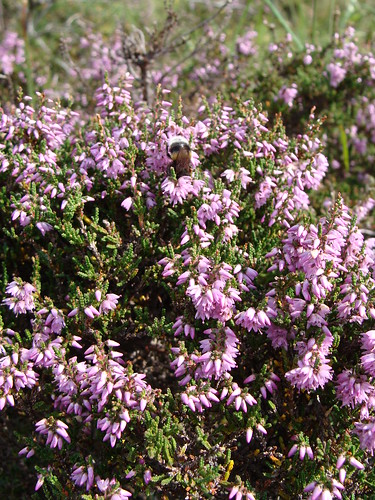In many of our forests, hills and mountains found a bush that does not usually raise much more than a meter of soil and often cover large areas. We can find various species and in this case is the Erica vagans L. took this picture in the zone of Puebla de Lillo at 1,200 m altitude in the month of August.

Scientific name: Erica vagans .
Taxonomía:
Reino: Plantae
Dvisión: Spermatophyta
Subdivisión: Magnoliofitha
Clase: Dicotyledoneae (Magnoliatae)
Subclase: Asteridae
Orden: Ericales
Familia: Ericaceae
Género: Erica
Especie : Erica vagans L.
Other names: heather, biércol, Rubona, CERs.
Habitat: Fits many areas and altitudes (can reach 3000 m) on calcareous soil only presents difficulties.
Description: Perennial shrub hardwood and thick roots. Their bell-shaped flowers have a look and appear in clusters, both the stigma and the stamens protrude from the corolla sepals is stuck (in Erica vagans L) . Ramosa is very tiny leaves and needles. It blooms from June to September-October.
use and applications : has diuretic and antiseptic properties, it is also astringent (diarrhea). Infusion is used in branches with flowers debiéndose leave stand at least 10 minutes .. Useful for inflammations of the urinary bladder and prostate. The roots of l heather you are a heavy strain that has been used in rural areas as fuel for its high calorific value, to be a very hard wood is used streak-free also for the manufacture of pipes smoking and other objects.
external use on wounds, eczema, trophic ulcers (or venous insufficiency), gingivitis, periodontal disease (gum enfermadades and fixation of the teeth), vulvovaginitis .
Antibacterial urological use. Hydroquinone, once absorbed derivative conjugates as glucuronides and sulfate esters. If the urine is alkaline, conjugates, especially sulfates partially hydrolyzed and free hydroquinone produces its antiseptic effect to be eliminated via the urine.
The antiseptic effect appears to be due to a decrease in the hydrophobicity of the bacterial wall. Chemical composition:
* simple phenols. Hydroquinone as arbutósido glycosides, arbutin.
* Tannins catechists, Proanthocyanidins.
* Flavonoids. Kenferol, quercetin, myricetin, taxifolin. Give anti-inflammatory properties.
* Triterpenes. Ursolic acid.
* Phenolic acids cinnamic acid derivatives. Chlorogenic acid. To give diuretic.
* phenolic compounds. Orcines, orcinol.
* Steroids. Beta-sitosterol.
Precautions:
contraindicated in case of gastritis and peptic ulcer disease.
not recommend using Heather for a period of one week due to hydroquinone may have a hepatotoxic effect. is advisable to provide an adequate intake of fluid (Up to 2 L / day) to prevent dehydration of the individual.
0 comments:
Post a Comment